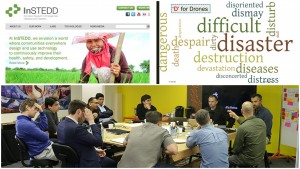“Can drones save lives?”
It’s a question that many outside the drone industry might find startling. Much of the general public still perceives drones as being deployed primarily for aerial surveillance or attacks in times of war. This view was certainly reinforced in the recent movie, “Eye in the Sky.”
However, that’s a very narrow view of drone technology and what it can do for business and society. Those of us inside the drone industry immediately know the answer to the question, “Can drones save lives?” Of course they can! They do it all the time.
Drones, or Unmanned Aerial Vehicles (UAV), already save lives in myriad ways, including emergency or disaster relief, humanitarian efforts or even in criminal investigations to help find suspects before they do more harm.
But that’s really the wrong question. Those of us inside the industry should really be asking ourselves, “How can drones save more lives?” I posed that question a few weeks ago to a group of elite drone developers during my keynote at the Singularity University Lab NASA Ames Research Center campus in the heart of Silicon Valley.
lives?” I posed that question a few weeks ago to a group of elite drone developers during my keynote at the Singularity University Lab NASA Ames Research Center campus in the heart of Silicon Valley.
The workshop, co-hosted by Cisco’s Corporate Social Responsibility program and InSTEDD, a non-profit providing innovative support for emergencies, diseases and disasters, brought together researchers, humanitarian aide workers and drone (UAV) experts last month as part of a three-day workshop. The workshop focused primarily on various applications and challenges faced by innovators to improve and extend drone solutions for humanitarian purposes.
We grappled with the issue I provoked. It’s clear that the full potential of drones has barely scratched the surface. Opportunities abound – not only to save more lives but also to enhance business and society in general.
 Humanitarian activities always pose their share of sticky political and logistical challenges, and the further adoption of drones just adds new layers of complexity. Although drones can augment and accelerate many Dirty, Dull, Difficult, and Dangerous activities undertaken by humans, numerous obstacles can arise during the fieldwork.
Humanitarian activities always pose their share of sticky political and logistical challenges, and the further adoption of drones just adds new layers of complexity. Although drones can augment and accelerate many Dirty, Dull, Difficult, and Dangerous activities undertaken by humans, numerous obstacles can arise during the fieldwork.
Over the past 20 years, I have personally encountered many of these challenges and learned some practical solutions. I’ve gained this valuable experience while supporting many disaster relief and humanitarian activities with another non-profit, BAPS Charities. As you can find in the following video, many of those practical challenges and tips were shared during my session.
Whether collaborating with multiple NGOs in the aftermath of a disaster or dealing with local authorities, a host of operational, technical and sustainability issues must be addressed in a very sensitive way. In my experience, I have found that the most critical first step – the cornerstone to drone success – is to build trust and credibility with the authorities at hand. Open-minded collaboration, persistence and authenticity of volunteers go a long way in establishing trust, especially during intensely traumatic circumstances.
We should be standing on the shoulders of the giants of this industry in the interest of achieving greater good. In addition to Cisco’s TacOps team, drone innovators such as Dr. Patrick Meier and Faine Greenwood have shown how the skillful combination of technological and collaborative people skills have led to successful humanitarian efforts leveraging drones.
Now is the time for all of us to learn from the best humanitarian efforts, build an ecosystem of genuine trust and keep our spirits high to help humanity at large.
Now is the time for us to flip the original question, “Can drones save lives?” and put it in a new perspective of, “How can drones save more lives?” There’s never been a better time for us to elevate the power of drones to save more lives. #NeverBetter
Humanity needs collaborative innovators! Are you ready to be one?

Yes and I am developing a drone for this core purpose.
great blog Biren – the drone/uav will be play the major role of “saving live”, “disaster monitoring, recovery” etc that related to major benefit for human being!
Very informative. Thanks
Awesome blog and very insightful talk, Biren. You talk with such passion about this topic. Wow!!
Drones definitely have a huge potential for humanity.
great blog